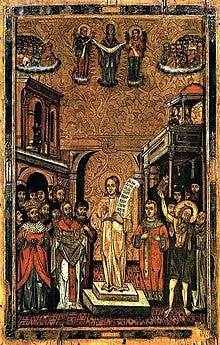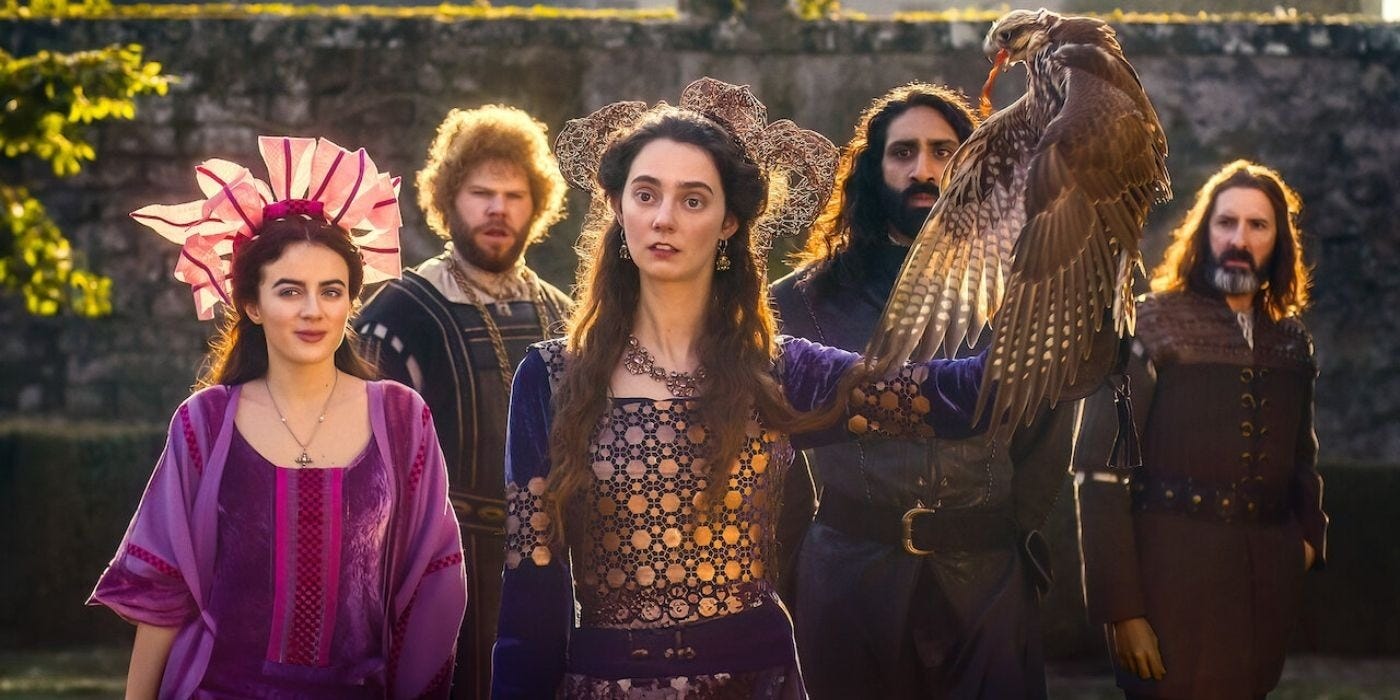Mozart and the Machzor
How the Mozart Requiem helped me understand the High Holidays
In the spirit of the coming season of repentance, let me make a confession:
In the very heart of the High Holidays, you’ll find me singing the Mozart Requiem.
I don’t mean the Latin. I mean a contrafact mashup of the bass solo “Tuba Mirum” with the first sixteen bars of the “Lacrymosa” for the Uv’shofar Gadol section of the liturgical magnum opus, Unetaneh Tokef.
Before you chide, hear me out.
Thank you for reading Beyond the Music! If you enjoy reading this newsletter, please consider supporting me with a paid subscription.
From my very first read of the liturgy of the Unetaneh Tokef, I felt immediately its liturgical parallel with the Dies Irae of the Requiem Mass. Both proclaim the call of the great trumpet (or shofar) heralding God’s final judgment, filling all Creation with fear and awe, followed by the opening of a great, cosmic book in which the judgment of all humankind will be recorded. Both liturgies invoke the apocalyptic vision of God’s final judgment, whether in this world or the world come.
I am not sure how Christians feel about the Dies Irae, but I do know that the Unetaneh Tokef makes many Jews uneasy. We all expect judgment day to come when we die, or maybe at the end of history — but not every single year! Yet the poem describes God’s judgment of all creation, for life or for death, between each and every Rosh Hashanah and Yom Kippur.
In the face of unbearable tragedy, whether personal or communal, this is a bitter liturgical pill to swallow. Many an article, sermon, and popular book have sought to solve the problem of what some have termed “Judaism’s most controversial prayer.” Like the Book of Job’s own subversion of biblical reward theology, those who suffer look at the poem’s purulent premonitions of predestination as something to oppose, avoid, or ultimately reinterpret.
My take is no different. But I think that a comparison with the Requiem adds a poignant counterpoint to the themes of the High Holidays. To get there, let’s examine the origin of these liturgies in antiquity.
I. Smells Like Byzantine Spirit
Most Jewish tales of the Unetaneh Tokef go back to an experience of martyrdom. The Or Zarua (13th c.) immortalized the poem as part of a terrifying tale of one Rabbi Amnon of Mainz, in which the dying rabbi proclaimed the prayer on Rosh Hashanah following gruesome torture by an archbishop. The story of Rabbi Amnon is likely a legendary tale rather than a historical account, but its martyrdom associations have come down to us to this day, recalling the monstrous persecutions that Jews endured and the puissance of their perseverant faith.
Yet the origins of Unetaneh Tokef go back much further than the middle ages. Scholars date the poem between the third and sixth centuries, composed in the Land of Israel which was then under the rule of the Roman (and after 330 CE, Byzantine) Empire. This makes it part of the earliest age of the piyyut, together with its great classical authors like Yannai and Yose b. Yose (the former was even long considered as a possible author of the otherwise anonymous poem). This was one of the great eras of cantorial history, as these cantor-poets of antiquity embellished the service with creative liturgical poetry made popular by its musical declamation.1

At the same time, nearby Byzantine Christianity was undergoing its own poetic evolution. The sixth and seventh centuries saw the expansion of the kontaktion, a homiletic genre of strophic sacred poetry made popular by Romanus the Melodist, a converted Jew who was a central figure in early Byzantine hymnography.
So when the twentieth-century Jewish musicologist Eric Werner discovered a hymn by Romanus with manifest allusions to the themes of the Dies irae, as well as to an eighth-century Geniza manuscript of the Unetaneh Tokef — he made an eager and, at first glance, convincing comparison:
Amazing — but don’t get your hopes up.
As the old scientific adage goes — correlation is not causation. Werner couldn’t quite grasp this, and made a forceful argument that the Dies irae liturgy had been brought into Byzantine Christianity specifically through Jewish influences.2 But further scrutiny shows the differences to be far greater than meets the eye. As John Planer wrote in his detailed article investigating this connection:
“The similarities Werner noted do not reveal direct or indirect influences, but rather are parallel themes in Christian eschatology originating in the Greek Scriptures. Motifs of angels, judgment, fear, trumpet/shofar blowing, and repentance are common to both Jewish and Christian traditions and far predate both liturgical poems. The Dies irae clearly draws upon these Christian sources—not U-n’taneh tokef.”3
But if the Dies irae is part of Christian motifs rather than Jewish ones, of what use can one make of the parallels between them? The answer, I believe, lies in the apocalyptic experience — both shared and particular to each faith.
II. Apocalypse Now?
The Dies irae itself also emerged in the context of Byzantine apocalypticism— a religious movement anticipating the end of the Christianized Roman Empire with the coming of God’s final judgment. This was based heavily on Jewish messianism and apocalyptic expectations. As Paul Alexander writes:
“The three observations—the identification of Last Roman Emperor and Jewish Messiah in the Cento of the True Emperor, Jerusalem as the scene of the surrender of imperial power, and the designation of the Last Roman Emperor as ‘redeemer’ or ‘savior’ in the Byzantine apocalypses—are…derived from the Jewish (post-canonical) national hope for a Messiah, an anointed king of the Jews who would free the Jewish people from the oppression by foreign powers.”4
While Jewish apocalyptic theologies went largely dormant as political movements following the destruction of the Second Temple, such ideas became active parts of emergent Christianity. The Unetaneh Tokef contains echoes of the similar end-of-days expectations of ancient Judaism, itself part of a larger liturgy envisioning a day in which God reasserts a hoped-for kingship over the entire world.
Though the Dies irae may have been generated in the wake of the Greek and Christian encounter with Jewish messianism, such apocalyptic thinking was driven largely to the fringe of rabbinic civilization. It is in this contrast that the Requiem is perhaps a most relevant counterpoint for High Holiday contemplation.
III. The Decameron —1353 and 2024
Apocalyptic thinking comes about when existential threats to society or our world seem so imminent that only a resolution, often violent, and/or a subsequent peaceful perfection can be imagined. Such ideas have been part of the soul-crushing spectre of the West, particularly in the wake of recent global threats like nuclear proliferation, climate change, and even the rise of AI. While such threats may be entirely real, the thinking that goes along with them can become rigid and fear-driven, often seeking a misanthropic or nihilistic escapism rather than actively seeking to do the good that one can.
Popular culture in America and beyond has reacted to this spectre with increasing consumption of horror and post-apocalyptic media, trying to resign itself to the timeless beauty of human relationships as the communally-mediated edifices of faith, culture, and hope crumble around us.
The recent Netflix series The Decameron puts this sort of post-apocalypticism into historical relief. Set in a sequestered villa outside Florence during the Black Death (1346-1353), the series follows a group of ten nobles and servants attempting to find their place and human connection in the all-consuming shadow of the bubonic plague. The show is a reboot of one of the great banned books of the Renaissance, Giovanni Boccacio’s Decameron (1353). Arguably the archetype of post-apocalyptic literature, both the original and the Netflix series encounter the world of the plague as one in which traditional values and social structures collapse, and people are pushed to encounter the difficult truths of their lives.
These dual Decamerons deride down social and gender norms, skewering religion and making new space for human desires and truths. This yields a predictably humanistic morality in a godless vacuum (which, as I wrote about the cantorial apocalyptic Between the Temples, is not entirely bad).
Yet this response to apocalypse is one of many. In this way, we may see both the Dies irae and the Unetaneh Tokef as religious responses to apocalypticism. Which brings us back to our opening musical reckoning with the end times — the Mozart Requiem.
IV. Amadeus Ex Machina
Wolfgang Amadeus Mozart (1756-1791) was no stranger to the irreverence of The Decameron. But when a “gray stranger” came to him to commission a Requiem, he took it as a sign of a personal apocalypse. What began as a premonition turned prophetic; Mozart poured his final creative energies into what would become his own funerary mass. He died in the middle of the composition on December 5, 1791. Mozart’s Requiem thus represents a man facing his very own death and judgment, and pouring all of his life’s energies into one last piece of art.
For the Jew, that piece of art is life.
Death pushes us towards a reckoning with ultimate meaning. But life is about more than its products — it is a process, a mode of being and doing.
As Rabbi Abraham Joshua Heschel said in his final interview (1972):
I would say to young people…let them remember that there is a meaning beyond absurdity.
Let them be sure that every little deed counts, that every word has power,
and that we do — everyone — our share to redeem the world, in spite of all absurdities, and all the frustrations, and all the disappointment.And above all, remember that the meaning of life is to live life as if it were a work of art.
How can one have such a philosophy facing apocalypse? It is partly because we have been through it before. The High Holidays are an annual apocalyptic rehearsal, a powerful Requiem encounter which recedes into the daily art of living. We don’t have to wait for the end-of-days to live with the raw truth and meaning of our last days on Earth.
This is why the Unetaneh Tokef begins with apocalypse and ends with perseverance: utshuvah utfilah utzedakah ma’avirin et ro’a hagezeirah — repentance, prayer, and good deeds make the evil of the decree pass. The evil does not cease to exist — it is that we recognize it from last year’s apocalpyse, and that we can, and will, move forward.
But what is more is that we do not go it alone. The main character of the entire High Holidays is God, who sees us all of the truth and mess and yet loves us and keeps faith and presence with us. Rather than a source of Decameronic pretense, God is a source of faithful perseverance.
The Great Shofar sounds, and we sit in the apocalypse. But then God takes our hand and loves us back into the art of living.
For details on the first cantor-poets in the Eretz Yisrael tradition, see Leon J. Weinberger, Jewish Hymnogrpahy: A Literary History (Liverpool: Liverpool University Press, 1998): 19-72.
See Eric Werner, The Sacred Bridge (New York: Columbia University Press, 1959): 252-255.
John Planer, “The Provenance, Dating, Allusions and Variants of U-n’taneh tokef and Its Relationship to Romanos’s Kontakion,” Journal of Synagogue Music 38/1 (Fall 2013): 163-192.
Paul J. Alexander, The Byzantine Apocalyptic Tradition (Los Angeles: University of California Press, 1985): 175-176.





Matt, I would love to hear your Mozart Mashup. Short of attending your service, where would I find it?
I guess I don’t need to tell you that many folks find a strong similarity between the standard tune for Zochreinu and the Verdi melody from the first version of Don Carlos that he reused as the Lacrymosa of his Requiem. L’shana tova, Steve Green